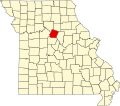Howard County, Missouri | |
|---|---|
 Howard County Courthouse in Fayette | |
| Nickname: Mother of Counties | |
 Location within the U.S. state of Missouri | |
| Coordinates: 39°08′N92°42′W / 39.14°N 92.7°W | |
| Country | |
| State | |
| Founded | January 23, 1816 |
| Named after | Benjamin Howard |
| Seat | Fayette |
| Largest city | Fayette |
| Area | |
• Total | 472 sq mi (1,220 km2) |
| • Land | 464 sq mi (1,200 km2) |
| • Water | 7.7 sq mi (20 km2) 1.6% |
| Population (2020) | |
• Total | 10,151 |
| • Density | 21.9/sq mi (8.45/km2) |
| Time zone | UTC−6 (Central) |
| • Summer (DST) | UTC−5 (CDT) |
| Congressional district | 4th |
| Website | https://www.mocounties.com/howard-county |
Howard County is located in the U.S. state of Missouri, with its southern border formed by the Missouri River. As of the 2020 census, the population was 10,151. [1] Its county seat is Fayette. [2] Settled originally by migrants from the Upper South, it is part of the region historically known as Little Dixie. It is part of the Columbia, Missouri, metropolitan area.
Contents
- History
- Geography
- Adjacent counties
- Major highways
- National protected area
- Demographics
- 2020 census
- 2000 census
- Education
- Public schools
- Private schools
- Post-secondary
- Public libraries
- Communities
- Cities and Towns
- Unincorporated communities
- Notable people
- Politics
- Local
- State
- Federal
- Missouri presidential preference primary (2008)
- See also
- References
- Further reading
- External links
The county was organized January 23, 1816, a year after the end of the War of 1812, and named for Benjamin Howard (1760-1814, served 1809-1813), two years after his death. He was an officer in the United States Army, and was appointed by President James Madison as the first Governor of the newly reorganized Missouri Territory (1812-1821), with its new capital city in nearby St. Louis. Governor Howard oversaw the new federal territory when it was separated from the previous larger Louisiana Territory of 1804-1812, which encompassed the vast uncharted Louisiana Purchase of 1803 when sold to the United States by the Emperor Napoleon I of France for $15 million dollars. The subsequent Missouri Territory was formed nine years later after the previous short-lived Louisiana Territory's southern portion along the lower Mississippi River including the former territorial capital at the major prosperous river port city of New Orleans was approved by the United States Congress and President Madison to be admitted to the federal Union as the 18th State of Louisiana in 1812.
This was just prior to the outbreak of the War of 1812, which heralded renewed conflict with the United Kingdom. Territorial Governor Howard was involved and instrumental in the hostilities, although he died in the midst of the war's last year, and before the British Army and Royal Navy attack in the Battle of New Orleans in January 1815, the famous last battle of the war a month after a peace treaty was signed in December 1814, in Europe. [3]
